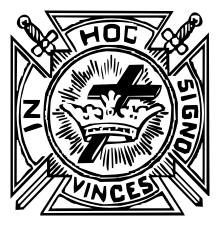This article is part of or related to the Knights Templar series |
| Part of a series of articles on Freemasonry | |
 | |
Core Articles Freemasonry · Grand Lodge · Masonic Lodge · Masonic Lodge Officers · Grand Master · Prince Hall Freemasonry · Regular Masonic jurisdictions · Continental Freemasonry History
|
The Knights Templar is an international philanthropic chivalric order affiliated with Freemasonry. Unlike the initial degrees conferred in a Masonic Lodge, which only require a belief in a Supreme Being regardless of religious affiliation, the Knights Templar is one of several additional Masonic Orders in which membership is open only to Freemasons who profess a belief in the Christian religion. The full title of this Order is The United Religious, Military and Masonic Orders of the Temple and of St John of Jerusalem, Palestine, Rhodes and Malta. The word "United" in this title indicates that more than one historical tradition and more than one actual Order are jointly controlled within this system. The individual Orders 'united' within this system are principally the Knights of the Temple (Knights Templar), the Knights of Malta, the Knights of St Paul, and only within the York Rite, the Knights of the Red Cross. The Order derives its name from the historical Knights Templar. One theory of the origins of Freemasonry claims direct descent from the historical Knights Templar through its final fourteenth-century members who took refuge in Scotland, or other countries where the Templar suppression was not enforced. Although the theory may not be dismissed, it is usually deprecated on grounds of lack of evidence by both masonic authorities[1] and historians.[2]
Administration
Knights Templar can exist either as part of the York Rite or as an independent organization. Though the York Rite and the independent versions share many similarities there are key differences which are described below.
[edit]Knights Templar as a part of the York Rite
Main article: York Rite
A Knights Templar commandery is traditionally the final body that a member joins in the York Rite after the chapter of Royal Arch Masons and a council of Royal & Select Masters. Some jurisdictions, however, allow members to skip over membership in a council. A local Knights Templar commandery operates under a state-level Grand Commandery, however American commanderies also operate under The Grand Encampment of the United States. This is unique among American Masonic bodies, as most report to the state level alone.
While a chapter bestows the Royal Arch degrees, and a council bestows the Cryptic degrees, a Knights Templar commandery bestows three orders and one passing order onto its members. This is opposed to the standard degree system found elsewhere in Freemasonry, and they are the only ones not to deal with the Hiramic Legend.[3] The York Rite orders are:
- The Illustrious Order of the Red Cross
- The Passing Order of St. Paul, (or Mediterranean Pass)
- The Order of the Knights of Malta (or simply Order of Malta)
- The Order of the Temple
[edit]Knights Templar as an Independent Body
Outside the York Rite, membership is by invitation only. Candidates are required to be Master Masons, and Royal Arch Masons, and to sign a declaration that they profess the Doctrine of the Holy and Undivided Trinity. In some Australian States, the requirement of being a Royal Arch Mason no longer applies.
Local bodies of Knights Templar are known as Preceptories; local bodies of Knights of St Paul are known as Chapters; local bodies of Knights of Malta are known as Priories; all operate under a Grand or Great Priory, often with an intermediate level of Provincial Priories. Although some jurisdictions maintain a separate Great Priory of the Temple and Great Priory of Malta (as, for example, in England), the Grand Master and other officers of both Great Priories hold simultaneous equal office in both bodies. Three degrees are administered in this system:
- The Degree of Knight Templar (Order of the Temple)
- The Degree of Knight of St. Paul (incorporating the Mediterranean Pass)
Contents[hide] |
Note: Please read " Blog Participation Requested - Announcement - Education", which explains and describes the purpose of this series of topics. This post does not make a statement "for" the following content and does not make claim that it has a direct relation to Freemasonry. It is for educational purposes only! All credit given to for content obtained from Wikipedia, the free encyclopedia.
Tupelo Masonic Lodge No. 318 F&AM
HOME - http://www.tupelomason.org/
BLOG - http://tupelomason.blogspot.com/
PHOTOS - http://tupelomason.shutterfly.com/




No comments:
Post a Comment
Your comments and suggestions are not only welcomed, but are encouraged. However, keep your comments within the limits of good taste and please, no business promotions or hyperlinks that do not contain links to reputable Masonic material. Please see our Legal Disclaimer for more details regarding the Terms of Use. Violation of this policy will result in your comment being deleted and/or you being banned from future use of this website.